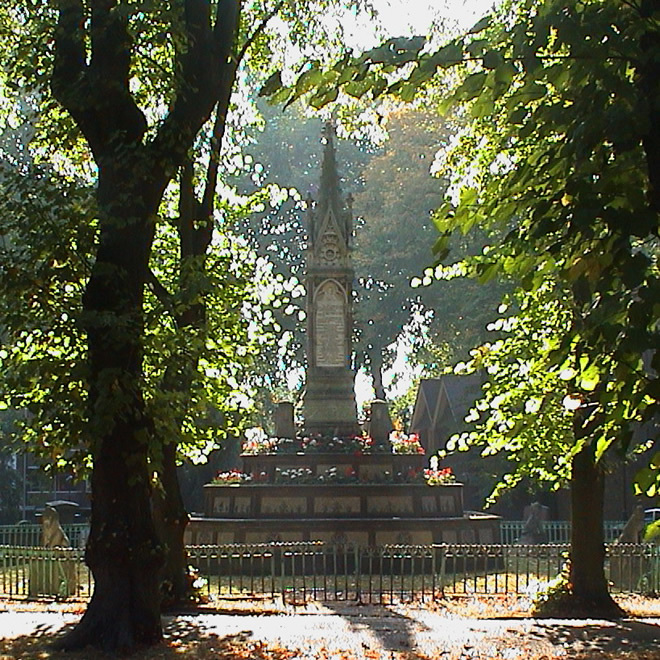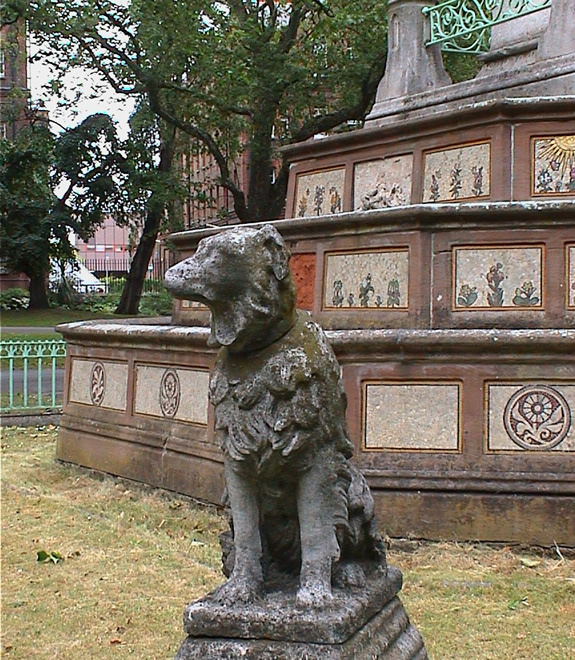Erection date: 1879
{On the front, west, face there is a long quotation from Matthew 5, not fully transcribed here, {followed by a prayer/poem:}
"Blessed are the poor in spirit . . ..
. . . . . . . . For they shall be called the children of God"
Here Christ's acre where this dial stands,
With pious care and borne with reverend hands,
Lone wanderers garnered in from east and west
Among the home-laid lie in solemn rest.
Severed in life by lineage, race, faith, clime,
They bid alike the last soft stroke of time.
And when God's sun which shone over their birth
Ends his bright course, and vigil o'er the earth,
When o'er this disc that day's last shadow flee,
And death no more divides us as does the sea,
The dead will rise, retake the life God gave,
Creation's saviour, bless earth's opening grave.
Thy word hath writ the blest no conscience clear,
In thought and word, all must thy judgement fear.
Only our own wild words which fashioned prayer
When life was parting, still move the ambient air
May, with the pure in heart, the godhead see.
{Integral to the metal sundial at the top of the west face is the Latin text which translates as "Time - the devourer of things":}
Tempus edax rerum.
{On the eastern face:}
These gardens, formed out of the burying ground of St Giles, and the churchyard of St Pancras, are assigned for ever to the loving care and use of the parishioners. Hereon are inscribed some names, English and foreign, which have an interest for all time. This dial is however especially dedicated to the memory of those whose graves are now unseen, or the record of whose names may have been obliterated.
{There follows a list of 74 names (many with a description such as "envoy from Naples") which continues across the southern and then the northern faces. This list can be seen at Subjects Commemorated. Note that the inscribed marble plaque on the southern face has been recreated, as part of a renovation:}
This elaborate piece of high Victoriana was designed by George Highton of Brixton in the decorative gothic style and is Grade II listed. It was unveiled in 1879 by Baroness Burdett-Coutts. The memorial is constructed of Portland stone, marble, granite and red Mansfield stone, with extensive mosaic enrichment depicting flowers and the seasons. There are stone animal statues on pedestals at each corner, at least one of which is thought to have been modelled on Baroness Burdett-Coutts' own collie dog.
The spire includes a sundial, relief carvings of St. Pancras (to the west) and St. Giles (to the east), Night and Morning, and a list of those once buried in the surrounding graveyards, which you can see here at Subjects Commemorated. The inscription is a little imprecise about how the names were selected but this memorial was erected about 10 years after many graves were dug up to make way for a new rail line (See Hardy's tree) so it seems likely the names listed are of the disinterred.
We are not overly impressed with the quality of the poem, transcribed above. Perhaps the author was not that proud of it either, since it is anonymous on the monument and we can find no trace of the poet responsible.
Site: Burdett-Coutts Memorial Sundial (1 memorial)
NW1, Pancras Road, St Pancras Gardens
Odd fact: The Beatles posed in these gardens for a photo shoot in 1968 after recording Hey Jude.
2023: This memorial has its own Facebook page.











Comments are provided by Facebook, please ensure you are signed in here to see them